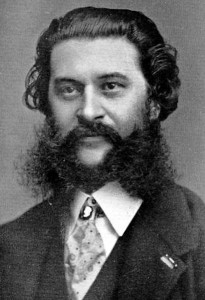J. Strauss, Frühlingsstimmen
 After the Lenten season of sacred works and last week’s war remembrance, we might want to turn our ears to major keys, snappy rhythms, and the voices of Spring (Frühlingsstimmen).
After the Lenten season of sacred works and last week’s war remembrance, we might want to turn our ears to major keys, snappy rhythms, and the voices of Spring (Frühlingsstimmen).
I have a tendency to think of Johann Strauss Jr. (1825-1899) as the “other Strauss.” There are those, I suppose, who think of Richard Strauss (1864-1949)—composer of tone poems like Also Sprach Zarathustra and operas like Rosenkavalier and Elecktra—as the “other Strauss.” The two composers shared a last name and shared screen time in the movie 2001: A Space Odyssey, but the similarities pretty much end there. And no, they were not related.
The subject of today’s post was the son of Johann Strauss I, who had become famous as a composer of waltzes. The father’s entrepreneurial flare enabled him to tour abroad with his orchestra and to be named Vienna’s Hofballmusikdirektor. Johann II followed in his father’s career path (although the father had intended his son to have a career in banking rather than music). Johann II apparently inherited both his father’s musical talent and entrepreneurialism. His productive years coincided with the height Vienna’s prosperity under Emperor Franz Joseph I. In 1863, Johann II was also named Hofballmusikdirektor, which gave him a prominent role in the Carnival Season each year. He too toured widely and became known as the “waltz king.”
Johann II was also influenced by Liszt and Wagner in the 1850s. He conducted Wagner’s music at a time when Wagner was not popular in Vienna. But it has been suggested that this influence took his orchestral writing to a higher level and enabled him to move the waltz from the ballroom to the concert hall. He receives credit for having liberated the waltz from its perfunctory 3/4 rhythm and monotonous melodies.
Frühlingsstimmen, op. 410 (1883), is a collection of waltzes written for orchestra with one of Johann II’s most famous melodies. The coloratura soprano (a topic discussed here) is optional.



